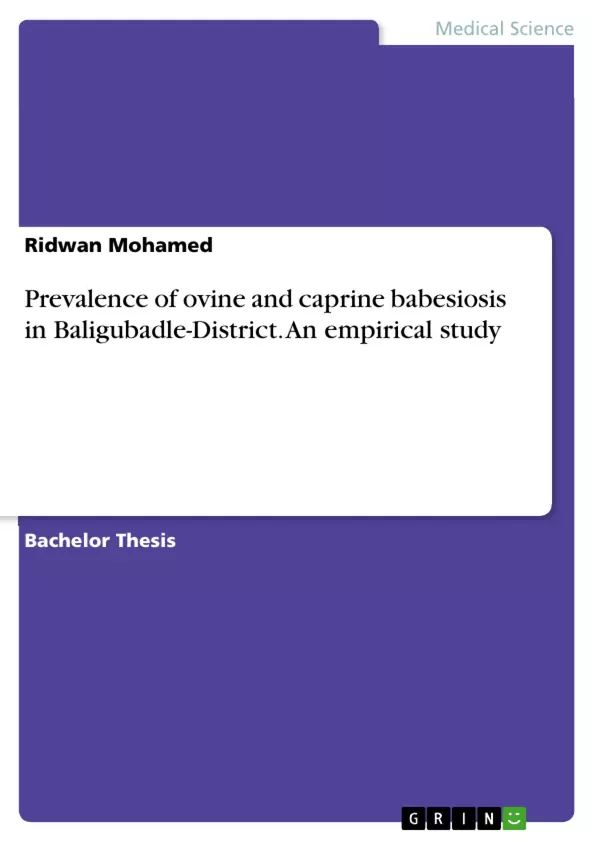This study was undertaken to know the Babesiosis prevalent in Ovine and Caprine in Baligubadle District, Hawd region, Somaliland. This study will add an additional advantage of the Babesiosis to cover the further way for launching sustainable animal disease controlling and minimizing in Somaliland. However there is little data on national herd distribution and composition up to date. Furthermore there is little information about the prevalence of Babesiosis in sheep and goats in Baligubadle district. Therefore this study is aimed at investigating the prevalence of sheep and goats Babesiosis in Baligubadle district, Somaliland.
Ovine and caprine babesiosis is an acute or chronic infectious disease of sheep and goats, caused by two species of Babesia, transmitted by ticks, and characterized by fever, anemia, hemoglobinuria and icterus. Ovine and Caprine Babesiosis is caused by two antigenically different species of Babesia: B. motasi, is a large and more virulent form, occurring singly or paired in erythrocytes; B. ovis which is a small form. The main objective of this study was to establish the prevalence of Babesiosis in sheep and goats in Baligubadle District, Somaliland.
Cross sectional study that has been carried out at 19 April up to 15 July in five villages in Baligubadle district. A total of 350 sheep and goats were sampled. Slides were made from a whole blood collected from the auricular vein of the animals. After staining, slides were read under a light microscope.
Inhaltsverzeichnis (Table of Contents)
- DEDICATION
- ACKNOWLEDGEMENT
- LIST OF FIGURES..
- ABBREVIATIONS..
- ABSTRACT..
- CHAPTER ONE: INTRODUCTION
- 1.1 Background Information.
- 1.2 Problem Statement
- 1.3 justification and significance of the study.
- 1.4 Objectives.
- 1.4.1 General Objectives .......
- 1.4.2 Specific Objectives.......
- CHAPTER TWO: LITERATURE REVIEW
- 2.1 Background of Babesiosis.....
- 2.2 Etiology
- 2.3 Lifecycle of the Tick.
- 2.4 Epidemiology
- 2.4.1 Transmission ..
- 2.4.2. Disease Geographical Distribution............
- 2.4.3 Host Range.
- 2.5 Pathogenesis......
- 2.6 Clinical Signs
- 2.7 Diagnosis
- 2.7.1 Clinical Diagnosis.
- 2.7.2 Differential Diagnosis
- 2.8 Laboratory Diagnosis.
- 2.8.1 Sampling
- 2.9 Treatment and Control
- CHAPTER THREE: METHODOLOGY...
- 3.1 Study Area...
- 3.2 Study Design
- 3.3 Study Population
- 3.4 Sample Size.
- 3.5 Sampling Method.
- 3.6 Materials.............
- 3.7 Data Analysis
- CHAPTER FOUR: RESULTS..
- 4.1 Democratic Characteristics of the Study Participants.
- 4.2 Overall prevalence of Babesiosis.
- 4.3 Prevalences of Babesiosis in Sheep and Goats.
- 4.4 Prevalence of Babesiosis in Adult and Young of Sheep and Goats.
- 4.5 Traditional Knowledge about Sheep and Goat Babesiosis
- CHAPTER FIVE: DISCUSSION
- CHAPTER SIX: CONCLUSIONS AND RECOMMENDATIONS.
- 6.1 Conclusion...........
- 6.2 Recommendation....
- REFERENCES..
- ANNEXES
- Annex One: Questionnaires
- Annex Two: Field Pictures.........
- Annex Three: Map of the Study Area......
Zielsetzung und Themenschwerpunkte (Objectives and Key Themes)
This study aims to determine the prevalence of ovine and caprine babesiosis in the Baligubadle district of Somaliland. The research was conducted to assess the prevalence of the disease in sheep and goats, considering factors such as age and sex of the animals. Additionally, the study explored traditional knowledge about sheep and goat babesiosis.
- Prevalence of ovine and caprine babesiosis in the Baligubadle district of Somaliland
- Impact of age and sex on the prevalence of babesiosis
- Traditional knowledge about sheep and goat babesiosis
- Understanding the epidemiology of babesiosis in the region
- Developing strategies for control and prevention of babesiosis in sheep and goats
Zusammenfassung der Kapitel (Chapter Summaries)
Chapter One provides an introduction to the research, outlining the background information on ovine and caprine babesiosis, the problem statement, the justification and significance of the study, and the objectives. Chapter Two delves into a comprehensive literature review, covering aspects such as the background of babesiosis, its etiology, the lifecycle of the tick, epidemiology, pathogenesis, clinical signs, diagnosis, and treatment and control measures. Chapter Three details the methodology employed in the study, including the study area, design, population, sample size, sampling method, materials used, and data analysis techniques. Chapter Four presents the findings of the research, focusing on the democratic characteristics of the study participants, the overall prevalence of babesiosis, and the prevalence of the disease in sheep and goats, considering factors like age and sex. It also explores traditional knowledge regarding sheep and goat babesiosis.
Schlüsselwörter (Keywords)
The core concepts and keywords of this study include ovine babesiosis, caprine babesiosis, Baligubadle district, Somaliland, prevalence, epidemiology, tick-borne disease, traditional knowledge, livestock health, veterinary medicine.
- Quote paper
- Ridwan Mohamed (Author), 2020, Prevalence of ovine and caprine babesiosis in Baligubadle-District. An empirical study, Munich, GRIN Verlag, https://www.grin.com/document/948233



